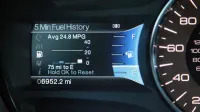How do today’s new vehicles match their EPA MPG ratings?

This business of writing about cars doesn’t pay a whole lot, but it does have its perks. Most important is the rare privilege of being able to drive, live with, and evaluate dozens of new vehicles each year through automaker press launch events, local loans, and the occasional road trip. In 2015, I was fortunate to spend varying amounts of quality time in some 76 new cars and trucks, and have kept a log of their key specs and real-world fuel efficiency.
These actual observed fuel-economy findings are far from scientific, since press test and loaner vehicles have had varying usage and mileage (some brand new, others well worn) when I get my time in them, and my driving needs vary from day to day. I work at home, so some get mostly local urban and suburban use, others see mostly 70-plus-mph freeway runs, some a mix of both. Some are also subjected to brief but aggressive two-lane test drives.
Still, I think my real-world mpg experiences probably correlate fairly well, at least within a reasonable range, with those of most others. And how each vehicle’s average fuel economy compares to its EPA combined (more predictive than city or highway) rating should be useful information for potential buyers. So ,what were my biggest 2015 hits and misses in that regard?
The 2015 Chevrolet Cruze diesel tops my observed economy list at 42 mpg, a full 9.0 mpg better than its EPA combined rating. But there’s good reason for that, since I dove it mostly at freeway speeds, where diesels typically shine, and its EPA highway number is an impressive 46 mpg. Tied for second at 5.8 mpg over their combined ratings are the 2015 Audi A3 TDI and VW Beetle TDI, which share the same 2.0L turbodiesel four and were also mostly freeway driven. It’s a crying shame that this fun-driving, frugal VW diesel has been discredited and discontinued (for now) as an emissions cheater.
But VW’s (presumably emissions-legal) gas-powered cars can be fuel-economy heroes as well, as a 2015 1.8L Sportwagon TSI, also driven mostly on freeways, impressed at a healthy five mpg over its 29-mpg combined rating. And a 2016 2.7L turbo-V6 Lincoln MKX CUV scored a surprising 4.5 mpg better than its (not-so-impressive) 19 mpg combined.
Next came a 2015 1.6L Kia Forte SX at 28.3 mpg vs. its 24-mpg rating, a 2015 1.8L VW Jetta TSI (34.2 mpg vs. 30) and a 2016 2.0L Chevrolet Malibu (30.1 vs. 27). Tied at 3.0 mpg over their EPA scores were a 2016 2.0L BMW 328i (27 mpg combined) and a 2016 3.5L Ford Edge CUV (20 mpg). Between 2.2 and 2.9 mpg over their combined EPA ratings were a 2015 1.6L Hyundai Accent GLS, a 2015 2.0L Hyundai Elantra GT, a 2015 3.6L Buick LaCrosse AWD, a 2016 3.3L Hyundai Santa Fe Limited AWD, a 2016 3.5L Nissan Maxima Platinum and a 2015 6.4L Dodge Challenger Scatback. For perspective, that eclectic set of six surprising vehicles carried EPA combined ratings of 30, 27, 20, 19, 25 and 17 mpg, respectively.
My biggest disappointment was a 2015 Toyota Prius v Four.
At the other end of my comparative fuel economy scale, my biggest disappointment was a 2015 Toyota Prius v Four, which delivered 34.4 mpg in a week of local driving that included an aggressive test. That seems pretty good for the largest, roomiest Prius … until you see its 42-mpg EPA combined rating. Next worst was a 2015 2.4L Mitsubishi Outlander SE S-AWC at 20 mpg vs. its 26-mpg rating. Then came a 2015 2.0L Lincoln MKC CUV at 17.7 mpg vs. 23 combined, a 2015 1.4L Chevrolet Trax at 24 mpg vs. 29, a 2015 1.5L Toyota Yaris 5-door SE at 28.7 vs. 33, a 2015 2.0L Audi S3 at 22 vs. 26, a 2016 3.5L Toyota Tacoma Limited Double Cab pickup at 16.1 vs. 20, a 2015 2.5L Mazda3 i Touring sedan at 25.4 vs. 29 mpg and a 2015 1.6L Hyundai Sonata Eco sedan at 28.5 vs. 32 mpg. The Yaris and Mazda3 had manual transmissions, and all but the Sonata were driven locally only.
Clustered between 2.1 and 2.8 mpg below their EPA combined ratings were a 2016 2.5L Mazda6 Grand Touring sedan (29.9 vs. 32), a 2015 2.0L Lexus NX 200t Sport CUV (21.7 vs. 24), a 2015 3.5L Lexus RC 350 F coupe (19.6 vs. 22), a 2015 2.5L Toyota RAV4 XLE CUV (23.4 vs. 26), a 2015 3.0L BMW X4 xDrive 35i CUV (19.3 vs. 22), a 2015 2.0L Hyundai Santa Fe Sport CUV (18.3 vs. 21) and a 2015 3.5L Acura TLX 3.5L ADV sedan (22.2 vs. 25). All were driven both locally and on freeways, and it seems odd that the ’16 3.3L V6-powered Santa Fe cited above did so much better (vs. EPA) than the ’15 2.0L turbo-four version.
The real-world “fuel economy” of the plug-ins depended almost entirely on how much I drove on their batteries alone
Of course, the real-world “fuel economy” of the two plug-in hybrids (PHEVs) and one extended-range EV (EREV) that came my way depended almost entirely on how much I drove on their batteries alone. On a long road trip with little opportunity to recharge, a Ford Fusion Energi PHEV delivered 36.8 mpg, pretty close to its “gas-only” EPA rating of 38 mpg. But a BMW i8 PHEV and a BMW i3 EREV, both of which stayed close to home and were regularly recharged, recorded 47.3 mpg (vs. its gas-only 28) and 74.1 mpg (vs. 39), respectively. One fine reason why (except for their cost) EREVs and PHEVs make excellent sense.
Related Video:





